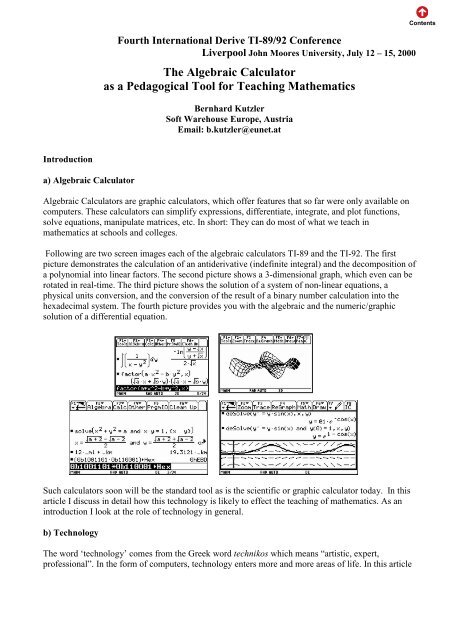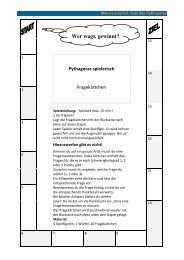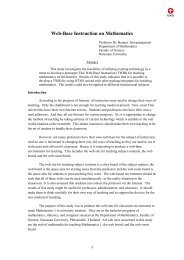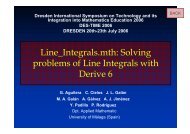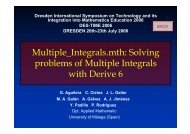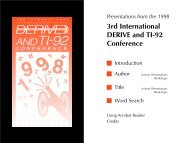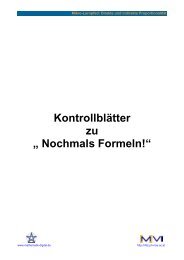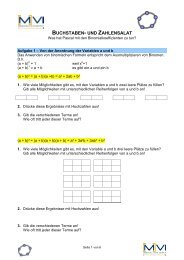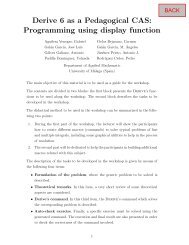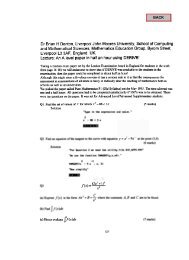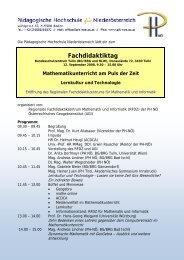The Algebraic Calculator as a Pedagogical Tool for Teaching ...
The Algebraic Calculator as a Pedagogical Tool for Teaching ...
The Algebraic Calculator as a Pedagogical Tool for Teaching ...
Create successful ePaper yourself
Turn your PDF publications into a flip-book with our unique Google optimized e-Paper software.
Introduction<br />
a) <strong>Algebraic</strong> <strong>Calculator</strong><br />
Fourth International Derive TI-89/92 Conference<br />
Liverpool John Moores University, July 12 – 15, 2000<br />
<strong>The</strong> <strong>Algebraic</strong> <strong>Calculator</strong><br />
<strong>as</strong> a <strong>Pedagogical</strong> <strong>Tool</strong> <strong>for</strong> <strong>Teaching</strong> Mathematics<br />
Bernhard Kutzler<br />
Soft Warehouse Europe, Austria<br />
Email: b.kutzler@eunet.at<br />
<strong>Algebraic</strong> <strong>Calculator</strong>s are graphic calculators, which offer features that so far were only available on<br />
computers. <strong>The</strong>se calculators can simplify expressions, differentiate, integrate, and plot functions,<br />
solve equations, manipulate matrices, etc. In short: <strong>The</strong>y can do most of what we teach in<br />
mathematics at schools and colleges.<br />
Following are two screen images each of the algebraic calculators TI-89 and the TI-92. <strong>The</strong> first<br />
picture demonstrates the calculation of an antiderivative (indefinite integral) and the decomposition of<br />
a polynomial into linear factors. <strong>The</strong> second picture shows a 3-dimensional graph, which even can be<br />
rotated in real-time. <strong>The</strong> third picture shows the solution of a system of non-linear equations, a<br />
physical units conversion, and the conversion of the result of a binary number calculation into the<br />
hexadecimal system. <strong>The</strong> fourth picture provides you with the algebraic and the numeric/graphic<br />
solution of a differential equation.<br />
Such calculators soon will be the standard tool <strong>as</strong> is the scientific or graphic calculator today. In this<br />
article I discuss in detail how this technology is likely to effect the teaching of mathematics. As an<br />
introduction I look at the role of technology in general.<br />
b) Technology<br />
<strong>The</strong> word ‘technology’ comes from the Greek word technikos which means “artistic, expert,<br />
professional”. In the <strong>for</strong>m of computers, technology enters more and more are<strong>as</strong> of life. In this article
Fourth International Derive TI-89/92 Conference<br />
I look at two are<strong>as</strong> and explain the importance and significance of technology therein. <strong>The</strong> two are<strong>as</strong><br />
are mathematics (intellectual) and moving/ transportation (physical). This comparison w<strong>as</strong> stimulated<br />
by Frank Demana.<br />
<strong>The</strong> most elementary method of moving is walking. Walking is a physical achievement obtained with<br />
mere muscle power. <strong>The</strong> corresponding activity in mathematics is mental calculation (mental<br />
arithmetic and mental algebra.) Mental calculation requires nothing but “brain power”.<br />
Riding a bicycle is a method of moving, where we employ a mechanical device <strong>for</strong> making more<br />
effective use of our muscle power. Compared to walking we can move greater distances or f<strong>as</strong>ter. <strong>The</strong><br />
corresponding activity in mathematics is paper and pencil calculation. We use paper and pencil <strong>as</strong><br />
“external memory” which allows us to use our brainpower more efficiently.<br />
Another method of moving is driving a car. <strong>The</strong> car is a device that produces movement. <strong>The</strong> driver<br />
needs (almost) no muscle power <strong>for</strong> driving, but needs new skills: He must be able to start the engine,<br />
to accelerate, to steer, to brake, to stick to the traffic regulations, etc. <strong>The</strong> corresponding activity in<br />
mathematics is calculator/ computer calculation. <strong>The</strong> calculator or computer produces the result,<br />
while its user needs to know how to operate it.<br />
What method of moving is sensible in which situation? If we <strong>as</strong>k a colleague to get a newspaper from<br />
a 250-meter distant newsstand, he probably will walk. In c<strong>as</strong>e the newsstand is 1,000 meters away, a<br />
bicycle may be the most re<strong>as</strong>onable means of transportation. In c<strong>as</strong>e the distance to the shop is 10,000<br />
meters, one will use a car. In mathematics, the sensible use of technology is accordingly: <strong>The</strong><br />
multiplication of two one-digit numbers is best done mentally. Two two-digit numbers can well be<br />
multiplied using paper and pencil, while <strong>for</strong> the product of two five-digit numbers one will use a<br />
calculator.<br />
One could throw in that “many students use a calculator to obtain the product of 7 and 9”, hence they<br />
are likely to loose the skill of per<strong>for</strong>ming mental arithmetic. This is a clear c<strong>as</strong>e of improper use of<br />
technology, which happens not just in mathematics. Some people misuse their car by driving 250<br />
meters to the next newsstand. Those, who do so, harm themselves (lack of physical exercise) and our<br />
environment (through the exhaust fumes). Despite the possible misuse of the car we do not demand<br />
its abolition. Similarly we should not banish calculators and computers just because some students<br />
might use them improperly. As much <strong>as</strong> we needed (and still need) to create a general awareness that<br />
physical exercises are essential <strong>for</strong> physical fitness and health, we need to create the awareness that<br />
intellectual exercises (mental arithmetic and mental algebra are such exercises) are essential <strong>for</strong><br />
intellectual fitness and health. More on this will be discussed in the l<strong>as</strong>t but first section.<br />
<strong>The</strong> analogy is not finished yet. What, if the colleague, who we <strong>as</strong>ked to get a newspaper from a 250<br />
meter away newsstand, can’t walk properly (because he is physically challenged or h<strong>as</strong> a broken leg)?<br />
For him, walking 250 meters can be very difficult, if not undoable. <strong>The</strong>re is technology available to<br />
help these people, <strong>for</strong> example a wheel chair. Using a wheel chair is a method of technologysupported<br />
moving, where a physical weakness is compensated. In an intellectual activity weaknesses<br />
could occur <strong>as</strong> well, whose compensation is desirable if not necessary. I give an example from<br />
mathematics teaching: A student with a weakness in solving systems of linear equations will find it<br />
difficult to solve analytic geometry problems, simply because the solving of a system of equations is<br />
a subproblem encountered frequently in analytic geometry. It is not only an act of humanity, but our<br />
Kutzler: <strong>The</strong> <strong>Algebraic</strong> <strong>Calculator</strong> <strong>as</strong> a <strong>Pedagogical</strong> <strong>Tool</strong> <strong>for</strong> <strong>Teaching</strong> Mathematics Page 2
Fourth International Derive TI-89/92 Conference<br />
pedagogical duty to provide this student with a tool which compensates his or her weakness, hence<br />
allowing the student to do analytic geometry properly despite the weakness.<br />
As we will demonstrate later with more examples, calculators and computers can be excellent<br />
mathematical compensation tools which allow less gifted students to deal with advanced topics. It<br />
goes without saying, that the ultimate goal in mathematics teaching is to weed out all weaknesses in<br />
skills that are regarded essential. A physically challenged person need not be tied to a wheel chair <strong>for</strong><br />
the rest of his life. A physician will endeavour to repair a patient’s physical disability <strong>as</strong> much <strong>as</strong><br />
possible, using an individual therapy. Similarly, a teacher should endeavour to repair a student’s<br />
intellectual/mathematical disability with a proper, individual therapy. In both c<strong>as</strong>es we will facilitate<br />
the patient’s “daily life with the disability“ – i.e. the time outside the therapy – by providing an<br />
appropriate compensation tool (wheel chair, calculator).<br />
Following is a summary of the analogy.<br />
Moving/Transportation Mathematics<br />
physical intellectual<br />
walking mental calculation<br />
riding a bicycle paper & pencil calculation<br />
driving a car calculator/computer calculation (automation)<br />
using a wheel chair calculator/computer calculation (compensation)<br />
<strong>Teaching</strong> with Technology<br />
B<strong>as</strong>ed on what we explained in the previous section, we distinguish two elementary uses of<br />
calculators or computers in teaching: automation and compensation. B<strong>as</strong>ed on these two application<br />
types, we demonstrate how one can use calculators and computers <strong>as</strong> valuable teaching tools by<br />
looking at four topics which I think are especially important in mathematics education: trivialisation,<br />
experimentation, visualisation, and concentration.<br />
a) Trivialisation<br />
<strong>The</strong> car broadened our “moving/transportation horizons” by trivialising moving up to certain<br />
distances. Similarly, the calculator broadens our “calculation horizons”.<br />
Remember the “old days” be<strong>for</strong>e scientific calculators? Exam questions or homework problems had<br />
to be chosen very carefully so that all intermediate and final results were “nice”. A “nice” result w<strong>as</strong><br />
an integer, a simple fraction, or a simple radical which, later in the calculation, often would disappear<br />
again. This w<strong>as</strong> important, <strong>as</strong> otherwise the students would have had to use most of their time<br />
per<strong>for</strong>ming arithmetic operations. With a scientific calculator one can multiply two seven-digit<br />
numbers <strong>as</strong> quickly <strong>as</strong> two one-digit numbers. <strong>The</strong> scientific calculator trivialises the per<strong>for</strong>ming of<br />
arithmetic operations.<br />
Drawing the graph of a linear function (e.g. y=2x+3) is simple once you know the geometric meaning<br />
of the two coefficients. Only a glimpse of talent and a ruler are enough to produce a proper graph.<br />
Kutzler: <strong>The</strong> <strong>Algebraic</strong> <strong>Calculator</strong> <strong>as</strong> a <strong>Pedagogical</strong> <strong>Tool</strong> <strong>for</strong> <strong>Teaching</strong> Mathematics Page 3
Fourth International Derive TI-89/92 Conference<br />
Drawing the graph of a function such <strong>as</strong> y=2sin(x/2)+cos(x) is much more difficult and the production<br />
of a proper graph requires a re<strong>as</strong>onable degree of talent <strong>for</strong> drawing. With a graphics calculator one<br />
can plot both functions within the same amount of time and talent. <strong>The</strong> graphics calculator trivialises<br />
the production of graphs.<br />
Computing the first derivative of y=x² is simple once you know the differentiation rule <strong>for</strong> powers.<br />
2<br />
Determining the first derivative of y= ln( sin(cos(tan( x − x+<br />
1))) ) , however, is a lot of work even<br />
<strong>for</strong> a good mathematician. <strong>The</strong> algebraic calculator can manage both examples within seconds. <strong>The</strong><br />
algebraic calculator trivialises algebraic (symbolic) computations. A landmark paper about<br />
trivialisation of algebraic computation in mathematics teaching is [Buchberger 1989], where the<br />
WhiteBox/BlackBox principle is introduced.<br />
<strong>The</strong> car (i.e. the trivialisation of moving and transportation) made a distance such <strong>as</strong> Los Angeles to<br />
San Diego e<strong>as</strong>ily manageable. In other words, moving and transportation t<strong>as</strong>ks that have been<br />
considered difficult in earlier times nowadays are fulfilled routinely with cars. Similarly, calculators<br />
and computers (i.e. the trivialisation of arithmetic, graphics, and algebra) in teaching mean that we<br />
can tackle<br />
• (more) complex problems and<br />
• (more) realistic problems.<br />
Kutzler: <strong>The</strong> <strong>Algebraic</strong> <strong>Calculator</strong> <strong>as</strong> a <strong>Pedagogical</strong> <strong>Tool</strong> <strong>for</strong> <strong>Teaching</strong> Mathematics Page 4
) Experimentation<br />
Fourth International Derive TI-89/92 Conference<br />
How did we discover all the mathematical knowledge we know today and how do we find more<br />
mathematical knowledge? According to one of the epistemologically oriented theories one can<br />
visualise the main steps of these discoveries <strong>as</strong> follows: Applying known algorithms produces<br />
examples. From the examples we observe properties, which are expressed <strong>as</strong> a conjecture. Proving<br />
the conjecture yields a theorem, i.e. guaranteed knowledge. <strong>The</strong> theorem‘s algorithmically usable<br />
knowledge is implemented in a new algorithm. <strong>The</strong>n the algorithm is applied to new data, yielding<br />
new examples, which lead to new observations, ...<br />
new<br />
algorithm<br />
implement<br />
algorithm<br />
example<br />
theorem<br />
new example<br />
apply observe<br />
conjecture<br />
prove<br />
This picture of a spiral, which demonstrates the path of discovery of (mathematical) knowledge, w<strong>as</strong><br />
proposed by Bruno Buchberger. A detailed description of Buchberger’s Creativity Spiral and<br />
references to related models can be found in the highly recommended (German language) book<br />
[Heugl/Klinger/Lechner 1996].<br />
In this spiral we find three ph<strong>as</strong>es. During the ph<strong>as</strong>e of experimentation one applies known algorithms<br />
to generate examples, then obtains conjectures through observation. During the ph<strong>as</strong>e of<br />
exactification conjectures are turned into theorems through the method of proving, then<br />
algorithmically useful knowledge is implemented <strong>as</strong> algorithms. During the ph<strong>as</strong>e of application one<br />
applies algorithms to real or fictitious data. Typically, the solution of real problems serves the<br />
purpose of m<strong>as</strong>tering or facilitating life, while the solution of fictitious problems serves the purpose<br />
of entertainment/diversion (e.g. mind puzzles) or the finding of new knowledge (i.e. the satisfaction<br />
of scientific curiosity).<br />
Mathematics is about 5,000 years old. <strong>The</strong> first 2,500 years it w<strong>as</strong> an experimental science and<br />
belonged to the cultural <strong>as</strong>sets of the Egyptians and other ancient civilisations. Using the above<br />
notions, it consisted only of the ph<strong>as</strong>es of experimentation and application. About 500 B.C. the Greek<br />
took the Egyptian mathematics and applied to it the deductive methods of their philosophy (i.e. they<br />
added the ph<strong>as</strong>e of exactification), thus establishing mathematics <strong>as</strong> the deductive science <strong>as</strong> we know<br />
it today. From then on scientific mathematics comprised all three ph<strong>as</strong>es. After the mathematical<br />
knowledge grew <strong>for</strong> a while, a group around the French mathematician Dieudonne (the group became<br />
Kutzler: <strong>The</strong> <strong>Algebraic</strong> <strong>Calculator</strong> <strong>as</strong> a <strong>Pedagogical</strong> <strong>Tool</strong> <strong>for</strong> <strong>Teaching</strong> Mathematics Page 5
Fourth International Derive TI-89/92 Conference<br />
known under the name “Bourbaki”) undertook a project aiming at writing down the mathematical<br />
knowledge of their time in a uni<strong>for</strong>m and concise manner. <strong>The</strong>y developed the system of “definitiontheorem-proof-corollary-...”,<br />
which h<strong>as</strong> become characteristic to modern mathematics. This Bourbaki<br />
system, being developed <strong>for</strong> the purpose of inner-mathematical communication, did without<br />
documenting the ph<strong>as</strong>e of experimentation, hence it consisted only of the ph<strong>as</strong>es of exactification and<br />
application.<br />
Gradually, Bourbakism lodged itself in teaching and learning. It h<strong>as</strong> become customary to teach<br />
mathematics by deductively presenting mathematical knowledge, then <strong>as</strong>king the students to learn it<br />
and use/apply it to solve home work and exam problems. This is <strong>as</strong> if one would have to learn<br />
walking (or cycling, or dancing, ...) by studying, understanding, then applying scientific descriptions<br />
of the muscle motions required <strong>for</strong> walking (or cycling, or dancing, ...) – instead of learning by trial<br />
and error (i.e. experimentation), <strong>as</strong> it is done naturally. Most of today’s psychological theories of<br />
learning consider learning to be an inductive process in which experimentation plays an important<br />
role. This is why Freudenthal demanded that we should not teach students something that they could<br />
discover themselves (see [Freudenthal 1979]).<br />
Hardly any mathematician on this planet could do mathematical research the way we demand our<br />
students to get into this subject. A student h<strong>as</strong> to “locally” build his individual little “house of<br />
mathematics”. A scientist does pretty much the same “globally”, i.e. on a much larger scale. For both<br />
the scientist and the student a substantial part of knowledge acquisition happens during the ph<strong>as</strong>e of<br />
experimentation. From this point of view it becomes understandable why so many students are at<br />
loggerheads with mathematics and one will demand that experimentation obtains its due position<br />
within the teaching of mathematics. Ph<strong>as</strong>es of experimentation should complete the traditional<br />
teaching methods – not substitute them! We do not advocate the return to Egyptian experimental<br />
mathematics. Simply, mathematics teaching should go through all three ph<strong>as</strong>es of the above spiral.<br />
However, it is understandable that, within the framework of today‘s curricula, there w<strong>as</strong> hardly any<br />
experimentation in the sense of Buchberger’s creativity spiral. This kind of experimentation,<br />
per<strong>for</strong>med with paper and pencil, is both time-consuming and error prone. Within the time available<br />
at school, students could produce only a very small number of examples <strong>for</strong> the purpose of observing<br />
and discovering, and a hefty portion of these examples could be faulty due to calculation errors. <strong>The</strong>re<br />
is nothing you can observe from only a few, partly wrong examples! From now on algebraic<br />
calculators enable students to experiment within almost all topics treated in mathematics teaching.<br />
<strong>The</strong>re is no limit to the number of examples the student can do and the electronic <strong>as</strong>sistant guarantees<br />
the correctness of the results. Talking about an <strong>as</strong>sistant: Records indicate that great mathematicians<br />
such <strong>as</strong> Carl Friedrich Gauss employed herds of human “calculators” without which they would not<br />
have made most of their famous findings.<br />
<strong>The</strong> great genius Johann Wolfgang Goethe called <strong>for</strong> “learning through doing and observing”. Using<br />
algebraic calculators we can now meet Goethe’s demand.<br />
c) Visualisation<br />
Visualisation means illustration of an object, fact, or process. <strong>The</strong> result can be graphic, numeric, or<br />
algebraic. Today, the term is mostly used <strong>for</strong> graphic illustrations of algebraic or numeric objects or<br />
facts. (<strong>The</strong> term is used either <strong>for</strong> the process of illustration or <strong>for</strong> the result of the illustration<br />
process.) Visualisation <strong>as</strong> a technique of teaching mathematics h<strong>as</strong> become important mostly in those<br />
Kutzler: <strong>The</strong> <strong>Algebraic</strong> <strong>Calculator</strong> <strong>as</strong> a <strong>Pedagogical</strong> <strong>Tool</strong> <strong>for</strong> <strong>Teaching</strong> Mathematics Page 6
Fourth International Derive TI-89/92 Conference<br />
countries, where graphics calculators are widely used. Today it is mainly used to acquire the<br />
competence of changing between representations, mostly <strong>for</strong> the purpose of studying the<br />
correspondence between algebraic and graphic representations. A typical example is studying how<br />
2<br />
the parameter a effects the shape of the graph of the function y= a⋅ x :<br />
Frank Demana and Bert Waits are the leading advocates of a teaching style that is called the “power<br />
of visualisation” (see [Demana/Waits 1990, 1992, 1994]).<br />
In the psychology of learning scientists discovered the concept of rein<strong>for</strong>cement and showed, that<br />
rein<strong>for</strong>cement works best if it follows the action immediately. An example from everyday life is a<br />
child who puts its hand on a hot stove. <strong>The</strong> immediate pain is the best prerequisite <strong>for</strong> the child to<br />
learn not to do this anymore. If the pain would be felt only several minutes later, the child probably<br />
would not connect it with the (long ago) touching of the hotplate and it probably would not learn<br />
anything.<br />
When using a calculator <strong>as</strong> a visualisation tool, the immediate feedback is of central importance. If<br />
you enter into your calculator, <strong>for</strong> example, x^2, then press the right key, the corresponding graph<br />
appears only fractions of a second later. <strong>The</strong> resulting picture can be discussed, the graph can be<br />
<strong>as</strong>sociated with the expression, etc. Consider a less gifted student and compare the learning effect<br />
when the student h<strong>as</strong> to draw the graph manually with when the student is allowed to use a calculator:<br />
A manually produced graph would take too much time and most probably it would have only a vague<br />
resemblance with the true graph. (“What can you observe from wrong examples?”) Only with the<br />
help of the calculator this student h<strong>as</strong> a realistic chance to memorise the correspondence between the<br />
expression and the (proper!) graph. Producing graphs with paper and pencil certainly continues to be<br />
a worthwhile activity which is important in learning to understand the correspondence between<br />
algebraic and graphic representations. However, immediacy and correctness are such crucial<br />
psychological factors, that providing less gifted students with an appropriate tool (such <strong>as</strong> a graphic<br />
calculator) is a pedagogical duty.<br />
If and how a teacher uses a tool <strong>for</strong> supporting an activity depends on the pedagogical goals<br />
connected with the activity. Helmut Heugl once said “If it is not (pedagogically) necessary to use an<br />
algebraic calculator, it is (pedagogically) necessary not to use the algebraic calculator.” This<br />
means, in particular, that the teacher becomes more and more important in a technology-supported<br />
mathematics education, hence the importance of teacher preservice and inservice training grows.<br />
d) Concentration<br />
We can compare teaching and learning mathematics with building a house, the “house of<br />
mathematics”. <strong>The</strong> topics which we teach and the dependencies between them are comparable to the<br />
storeys of a house. Be<strong>for</strong>e one can build the house’s second storey, one h<strong>as</strong> to complete its first.<br />
Kutzler: <strong>The</strong> <strong>Algebraic</strong> <strong>Calculator</strong> <strong>as</strong> a <strong>Pedagogical</strong> <strong>Tool</strong> <strong>for</strong> <strong>Teaching</strong> Mathematics Page 7
Fourth International Derive TI-89/92 Conference<br />
Similarly, the treatment of almost any mathematical topic requires the m<strong>as</strong>tery of earlier learned<br />
topics. We demonstrate this using the topic “solving of a linear equation in one variable”.<br />
We look at the equation 5x-6=2x+15. One h<strong>as</strong> to trans<strong>for</strong>m it into the <strong>for</strong>m x=... . This is achieved<br />
through choosing and applying an appropriate sequence of equivalence trans<strong>for</strong>mations. Typically,<br />
the student is advised to “bring terms with x to one side of the equation” and to “bring all other terms<br />
to the other side”. <strong>The</strong>re<strong>for</strong>e we start by subtracting 2x:<br />
5x-6 = 2x+15 | -2x<br />
After choosing this equivalence trans<strong>for</strong>mation, we apply it to both sides of the equation i.e. we have<br />
to simplify:<br />
3x-6 = 15<br />
Now we have to choose another equivalence trans<strong>for</strong>mation, namely +6:<br />
3x-6 = 15 | +6<br />
And we simplify again:<br />
3x = 21<br />
We are interested in the practice of teaching mathematics. In particular we want to know why<br />
students make what errors. A typical mistake starts with the following argument: “<strong>The</strong>re is a 3 in<br />
front of the variable x. To get rid of the 3 I need to subtract 3”. This student is most likely to write ...<br />
3x = 21 | -3<br />
x = 18<br />
..., believing that the equation is solved.<br />
What goes wrong and how can technology help to make it better? An analysis of the steps taken<br />
above reveals two alternating t<strong>as</strong>ks: (1) the choice of an equivalence trans<strong>for</strong>mation and (2) the<br />
simplification of algebraic expressions. Here, the choice of an equivalence trans<strong>for</strong>mation is a higherlevel<br />
t<strong>as</strong>k insofar <strong>as</strong> it is the essence of the strategy <strong>for</strong> finding the solution of an equation. It is the<br />
new skill which the student h<strong>as</strong> to learn when learning to solve equations. <strong>The</strong> simplification of<br />
expressions is a lower-level t<strong>as</strong>k, <strong>for</strong> which the teacher h<strong>as</strong> to <strong>as</strong>sume that the student is sufficiently<br />
well trained.<br />
This picture demonstrates that a student, while trying to learn a new skill, repeatedly h<strong>as</strong> to interrupt<br />
the learning process in order to per<strong>for</strong>m a calculation. This is <strong>as</strong> if one would repeatedly be<br />
interrupted during a difficult chess game. In fact, it is even worse, because the interruption can<br />
Kutzler: <strong>The</strong> <strong>Algebraic</strong> <strong>Calculator</strong> <strong>as</strong> a <strong>Pedagogical</strong> <strong>Tool</strong> <strong>for</strong> <strong>Teaching</strong> Mathematics Page 8
Fourth International Derive TI-89/92 Conference<br />
influence the “game”: A mistake made during the interruption, i.e. during the lower-level t<strong>as</strong>k,<br />
severely disturbs the higher-level t<strong>as</strong>k and may prevent the student from learning. This is exactly<br />
what leaded to the wrong solution x=18 in the above example: After deciding to subtract 3, the<br />
student should fully concentrate on subtracting 3 from both sides of the equation while “<strong>for</strong>getting”<br />
the re<strong>as</strong>on <strong>for</strong> choosing this equivalence trans<strong>for</strong>mation. But, in reality, the student starts the next line<br />
with “x=” simply “because the trans<strong>for</strong>mation –3 w<strong>as</strong> chosen in order to generate x= on the left hand<br />
side”. At the higher level the student h<strong>as</strong> the (wrong) impression that –3 simplified the equation <strong>as</strong><br />
desired.<br />
This continuous change of levels inevitably occurs in almost all topics in school mathematics. It<br />
appears to be one of the central problems in mathematics education that students have to learn a new<br />
ability/skill while still practising an “old” one.<br />
Using an algebraic calculator the learning process could be conducted <strong>as</strong> follows. First we enter the<br />
equation.<br />
5x-6=2x+15 (ENTER)<br />
<strong>The</strong>n follows the input of the equivalence trans<strong>for</strong>mation. (<strong>The</strong> calculator automatically applies the<br />
subtraction operator to the l<strong>as</strong>t expression, i.e. the equation <strong>as</strong> its first argument.)<br />
-2x (ENTER)<br />
<strong>The</strong> simplification, i.e. the application of the equivalence trans<strong>for</strong>mation to both sides of the equation,<br />
w<strong>as</strong> per<strong>for</strong>med by the calculator. <strong>The</strong>n the student chooses the next equivalence trans<strong>for</strong>mation:<br />
+6 (ENTER)<br />
We mimic a student who makes the above discussed mistake:<br />
-3 (ENTER)<br />
It goes without saying that the calculator simplifies properly, hence the student receives an immediate<br />
feedback that the trans<strong>for</strong>mation –3 w<strong>as</strong> not successful (i.e. did not simplify the equation to “x=”).<br />
Here we meet again two issues that we discussed earlier: (1) <strong>The</strong> student experiments with possible<br />
equivalence trans<strong>for</strong>mations, hence there is an experimental learning ph<strong>as</strong>e, and (2) the immediacy of<br />
the result of applying the trans<strong>for</strong>mation tallies with what we <strong>as</strong>ked <strong>for</strong> in the section on visualisation.<br />
Kutzler: <strong>The</strong> <strong>Algebraic</strong> <strong>Calculator</strong> <strong>as</strong> a <strong>Pedagogical</strong> <strong>Tool</strong> <strong>for</strong> <strong>Teaching</strong> Mathematics Page 9
Fourth International Derive TI-89/92 Conference<br />
A student who follows the above calculator-supported exercise can fully concentrate on the (higherlevel)<br />
skill of choosing an equivalence trans<strong>for</strong>mation. <strong>The</strong> lower-level skill of simplification is<br />
per<strong>for</strong>med (at le<strong>as</strong>t <strong>for</strong> the moment) by the calculator.<br />
In [Kutzler 1998a] I give detailed instructions how to use a TI-92 (or TI-89) to teach/learn solving of<br />
linear equations. <strong>The</strong> above algebraic approach is discussed in further detail <strong>as</strong> well <strong>as</strong> numeric and<br />
graphic approaches.<br />
<strong>The</strong> Scaffolding Method<br />
In the above subsection on concentration we compared teaching mathematics with building a house.<br />
In the language of this metaphor the above-mentioned problem of mathematics education translates<br />
into the problem of building a new storey on top of an incomplete storey. For example, <strong>as</strong> soon <strong>as</strong> we<br />
start building the storey of “choosing equivalence trans<strong>for</strong>mations”, the storey of “simplifying” is still<br />
incomplete <strong>for</strong> many of our students. In mathematics teaching at school we simply don’t have enough<br />
time <strong>for</strong> waiting until all students have completed all previous storeys. <strong>The</strong> curriculum <strong>for</strong>ces the<br />
teacher to continue with the next topic, independent of the progress of individual students. So, it<br />
remains to <strong>as</strong>k how a student can build a storey on top of an incomplete one.<br />
<strong>The</strong> above example demonstrates how I suggest answering this question: While the student learns the<br />
higher-level skill, the calculator solves all sub-problems that require the lower-level skill. Using the<br />
language of the metaphor, the calculator is scaffolding above the incomplete storey.<br />
Using the example of solving a linear equation we demonstrated the use of an algebraic calculator <strong>as</strong><br />
scaffolding above the simplification storey. In the sequel we apply the scaffolding method to another<br />
example, namely the solving of a system of linear equations with Gaussian elimination.<br />
We use the system 2x+3y=4, 3x-4y=5. First, the student enters the equations:<br />
2x+3y = 4 (ENTER)<br />
3x-4y = 5 (ENTER)<br />
Gaussian elimination requires us to choose a linear combination of the two equations such that one<br />
variable is eliminated. This is what needs to be learned. Everything else (simplification, substitution,<br />
Kutzler: <strong>The</strong> <strong>Algebraic</strong> <strong>Calculator</strong> <strong>as</strong> a <strong>Pedagogical</strong> <strong>Tool</strong> <strong>for</strong> <strong>Teaching</strong> Mathematics Page 10
Fourth International Derive TI-89/92 Conference<br />
solving of an equation in one variable) are prerequisites of which the teacher expects that the students<br />
are well enough trained.<br />
We try to eliminate y by adding four times the first equation and three times the second equation. (On<br />
both the TI-92 and the TI-89 there is a simple technique <strong>for</strong> auto-p<strong>as</strong>ting a previously entered<br />
equation into the entry line. We don’t give the details here.)<br />
4*( .... first equation ... )+3*( ... second equation ... ) (ENTER)<br />
Voila. Variable y disappeared <strong>as</strong> requested. What is the practice of teaching this topic at school?<br />
Some students choose the right linear combination, but, due to a calculation error, the variable does<br />
not disappear. Other students choose a wrong linear combination, but, again due to a calculation<br />
error, the variable disappears (because it “must” disappear.) For both groups of students their<br />
weakness in algebraic simplification is a stumbling block <strong>for</strong> successfully learning the b<strong>as</strong>ic<br />
technique of Gaussian elimination. Exactly those students lag behind more and more the “higher”<br />
they get in the house of mathematics.<br />
In the above exercise, the algebraic calculator is scaffolding that compensates any weakness with the<br />
lower-level skills, hence it helps avoiding mistakes. In c<strong>as</strong>e the final teaching goal is to have students<br />
be able to solve systems of equations (or per<strong>for</strong>m any other skill B) manually (because, <strong>for</strong> example,<br />
the students are <strong>as</strong>sessed centrally at the end of the school year), then it is recommended to per<strong>for</strong>m<br />
the following three steps. <strong>The</strong> first step is teaching and practising skill A. <strong>The</strong> second step is teaching<br />
and practising skill B, while using the algebraic calculator to solve all those sub-problems that require<br />
skill A (i.e. the student can fully concentrate on learning skill B.) <strong>The</strong> third step is to combine skills A<br />
and B with no support from technology.<br />
This is one of many conceivable methods of using algebraic calculators and computers <strong>as</strong> pedagogical<br />
tools.<br />
<strong>The</strong> temporary use of technology can help to break down the learning process into smaller, e<strong>as</strong>ier<br />
“digestible” pieces. For less gifted students, who could not swallow the “big pieces” we offered them<br />
so far, this may be the only way of m<strong>as</strong>tering these learning steps. <strong>The</strong>y find it e<strong>as</strong>ier to keep track of<br />
the steps without getting lost (or screwed up) in details such <strong>as</strong> simplification. When comparing the<br />
teaching of mathematics with building a house, the use of technology compares with using<br />
scaffolding.<br />
Kutzler: <strong>The</strong> <strong>Algebraic</strong> <strong>Calculator</strong> <strong>as</strong> a <strong>Pedagogical</strong> <strong>Tool</strong> <strong>for</strong> <strong>Teaching</strong> Mathematics Page 11
Fourth International Derive TI-89/92 Conference<br />
<strong>The</strong> scaffolding method is any pedagogically justified sequence of using and not using technology <strong>for</strong><br />
trivialisation, experimentation, visualisation, or concentration either in the sense of automation or<br />
compensation.<br />
<strong>The</strong> presented use of technology <strong>as</strong> a pedagogical tool is completely independent whether or not<br />
technology may be used during an exam. <strong>The</strong> scaffolding method aims at supporting the learning<br />
process, i.e. it can help reaching (traditional) teaching goals. Here, technology is only a training<br />
instrument. Like a home trainer can help us acquiring physical skills, an algebraic calculator can help<br />
us acquiring intellectual/mathematical skills. Consequently, technology should be introduced <strong>as</strong> a<br />
pedagogical tool independently of any changes to the curriculum or the <strong>as</strong>sessment scheme. <strong>Algebraic</strong><br />
calculators can help at all levels of mathematics in secondary education.<br />
In [Kutzler 1998b] I describe how one can use a TI-92 (or a TI-89) to treat the topic “solving of<br />
systems of linear equations” at school. Besides giving further details on the above approach, the<br />
booklet also describes numeric and graphic methods <strong>as</strong> well <strong>as</strong> the substitution method.<br />
Goals of mathematics education<br />
I believe that the two central goals in mathematics education should be to train the students in the two<br />
disciplines intellectual sports and problem solving.<br />
a) Intellectual sports<br />
Given the existence of algebraic calculators, Bruno Buchberger raised the question “Why Should<br />
Students Learn Integration Rules?” ([Buchberger 1989]) and Wilfried Herget <strong>as</strong>ked “How Much<br />
Simplification Do We Need?” (“Wieviel Termum<strong>for</strong>mung braucht der Mensch?”), see the remark on<br />
page 8 in [Hischer 1992]. In all are<strong>as</strong> of life we need to <strong>as</strong>k how far we should go in automation.<br />
At the beginning we compared mathematics with moving/transportation. Our transportation<br />
technology is far enough developed so that we would not need to walk at any time in our life. We<br />
could use moving tools from infancy on. But we don’t do it. We know, that this would be dev<strong>as</strong>tating<br />
<strong>for</strong> our physical fitness and health: Our muscles would – because never used – degenerate, and this<br />
would certainly effect the whole body.<br />
Due to a m<strong>as</strong>sive incre<strong>as</strong>e of automation over the p<strong>as</strong>t years, many of our intellectual skills are in<br />
jeopardy. In the p<strong>as</strong>t we needed to memorise phone numbers – today we just use the phone’s memory<br />
keys. In the p<strong>as</strong>t we had to memorise how to program the video recorder – today we just swipe a bar<br />
code reader over the TV programme. It goes without saying that all this makes life so much more<br />
com<strong>for</strong>table. BUT it leads us to loosing what I call “intellectual fitness”. Many teachers complain<br />
about students‘ lack of concentration and their weak memories. <strong>The</strong>se are two typical symptoms <strong>for</strong> a<br />
diminishing intellectual health.<br />
In medicine there exist definitions of what a “healthy” person must be able to do physically. After a<br />
heart attack, <strong>for</strong> example, a patient must be able to walk a certain distance and to take the stairs a<br />
certain number of levels be<strong>for</strong>e he is considered cured. We need something similar <strong>for</strong> our intellectual<br />
Kutzler: <strong>The</strong> <strong>Algebraic</strong> <strong>Calculator</strong> <strong>as</strong> a <strong>Pedagogical</strong> <strong>Tool</strong> <strong>for</strong> <strong>Teaching</strong> Mathematics Page 12
Fourth International Derive TI-89/92 Conference<br />
capabilities, i.e. a definition of what an “intellectually healthy” person must be able to do in terms of,<br />
<strong>for</strong> example, memorisation, or mental calculations.<br />
For what concerns our physical capabilities, we introduced the school subject “sports” in order to<br />
fight a further deterioration. We need to take similar steps regarding our intellectual capabilities, e.g.<br />
we need the introduction of a school subject “intellectual sports”. I believe that this should be one of<br />
the goals of mathematics education.<br />
b) Problem solving<br />
In mathematics I consider problem solving to be the ability to use mathematical tools <strong>for</strong> solving real<br />
world technical problems. Characteristic <strong>for</strong> problem solving are the three steps shown in the graphics<br />
below. <strong>The</strong> first step is choosing the model and translating the real world problem into the language<br />
of the model, which requires us to gr<strong>as</strong>p and understand the problem. (An optimisation problem, <strong>for</strong><br />
example, would translate into a function to be optimised and equations which describe any constraints<br />
between the variables involved.) <strong>The</strong> second step is applying the available algorithms to solve the<br />
model problem PM, yielding a model solution SM. <strong>The</strong> third step, finally, is to translate the model<br />
solution into a real world solution S. (Often, people refer to this re-translation <strong>as</strong> interpretation.)<br />
However, now we still need to test, if S actually is a solution of P. In c<strong>as</strong>e it is not, then the whole<br />
process (i.e. all three steps) need to be repeated, because the mistake or error could be anywhere: <strong>The</strong><br />
chosen model may be inappropriate, the translation may be faulty, or the calculation may be wrong.<br />
Today, problem solving is treated at school only half-heartedly. <strong>The</strong> main emph<strong>as</strong>is is put on the<br />
second step, calculation, and its execution with paper and pencil. <strong>The</strong>re<strong>for</strong>e, most problem solving<br />
exercises turn into exercises <strong>for</strong> practising calculation skills. Since translation hardly is taught<br />
explicitly, it is understandable that a majority of students don’t develop this ability, hence they are<br />
afraid of this type of exercises. As a consequence, most students believe that such exercises are only<br />
<strong>for</strong> the most ingenious among them.<br />
By employing technology <strong>as</strong> widely <strong>as</strong> possible, we can dedicate enough time to teach the choosing<br />
of models and the translating. Once these skills are taught explicitly, more students will appreciate<br />
and m<strong>as</strong>ter them.<br />
c) <strong>The</strong> future of teaching mathematics<br />
Curricula should aim at educating students in the disciplines intellectual sports and problem solving.<br />
Kutzler: <strong>The</strong> <strong>Algebraic</strong> <strong>Calculator</strong> <strong>as</strong> a <strong>Pedagogical</strong> <strong>Tool</strong> <strong>for</strong> <strong>Teaching</strong> Mathematics Page 13
Fourth International Derive TI-89/92 Conference<br />
<strong>The</strong> goal of intellectual sports are intellectual fitness and health <strong>as</strong> h<strong>as</strong> been described in detail earlier.<br />
It goes without saying that technology should only be a training tool (“mathematical home trainer”)<br />
and must not be used when testing these abilities.<br />
<strong>The</strong> goal of problem solving is the ability of using given tools <strong>for</strong> solving given problems. It goes<br />
without saying that the use of technology should be highly welcome here.<br />
Once again I draw a parallel using the initial comparison of mathematics with moving/transportation.<br />
Problem solving compares with an actual desire of moving from A to B (or transporting something<br />
from A to B). Only the reaching of B counts. It is less important (maybe even unimportant) how we<br />
got there. Intellectual sports compares with a jogger who runs along a track in order to gain physical<br />
fitness. Only the jogging counts. It is unimportant where the track is or where it leads to. Transferred<br />
to mathematics this means the following: In problem solving only the result counts. It is irrelevant<br />
how the calculations were per<strong>for</strong>med. In intellectual sports only the per<strong>for</strong>ming of the calculation<br />
counts, while the result is unimportant.<br />
d) Assessment<br />
<strong>The</strong> above yields a very simple rule <strong>for</strong> <strong>as</strong>sessment: When <strong>as</strong>sessing intellectual fitness, no tool is<br />
allowed, not even a simple four-function calculator. When <strong>as</strong>sessing problem solving, all tools are<br />
allowed (better: solicited), in particular graphic or algebraic calculators. In c<strong>as</strong>e this splitting is not<br />
manageable within an exam, one should <strong>as</strong>sess the two disciplines at different times. It is obvious to<br />
draw a parallel with ice-skating: Intellectual sports compare with the compulsory exercise, in which<br />
the athlete demonstrates the m<strong>as</strong>tery of the b<strong>as</strong>ic techniques. Problem solving compares with the<br />
voluntary exercise (freestyle), in which the athlete demonstrates the ability to combine the b<strong>as</strong>ic<br />
techniques into a nice choreography. <strong>The</strong> total score depends on the scores of both the compulsory<br />
and the voluntary part.<br />
*<br />
In the end technology should play a secondary role in both disciplines. In intellectual sports the goal<br />
is a per<strong>for</strong>mance with a minimum of tools. In problem solving the goal is to learn all those skills and<br />
abilities that are needed <strong>for</strong> problem solving and that are not supported by any technology. A good<br />
mathematics education will use a calculator or computer like language education uses dictionaries.<br />
Concluding remarks<br />
William Shakespeare once said: “Nothing is either good or bad – only thinking makes it so.” Looking<br />
at technology <strong>for</strong> (mathematics) teaching one may change this into: “<strong>Calculator</strong>s and computers are<br />
neither good nor bad teaching tools – only using makes them so.” When driving a car, the most<br />
important is the driver – the car is secondary. Similarly, when teaching with technology the most<br />
important is the teacher – technology comes second. This is another plea <strong>for</strong> strengthening teacher<br />
preservice and inservice training.<br />
In Austria in 1991 all general high schools (Gymn<strong>as</strong>ien) and technical high schools (Höhere<br />
Technische Lehranstalten) were equipped with the DERIVE computer algebra system. In the sequel a<br />
research project w<strong>as</strong> conducted which became known <strong>as</strong> the “Austrian DERIVE Project”. <strong>The</strong> project<br />
involved 800 students who were taught regular mathematics with DERIVE. <strong>The</strong> results were<br />
Kutzler: <strong>The</strong> <strong>Algebraic</strong> <strong>Calculator</strong> <strong>as</strong> a <strong>Pedagogical</strong> <strong>Tool</strong> <strong>for</strong> <strong>Teaching</strong> Mathematics Page 14
Fourth International Derive TI-89/92 Conference<br />
published in the German language book [Heugl/Klinger/ Lechner 1996] and can also be found in the<br />
English language publication [Aspetsberger/Fuchs 1996]. In the academic year 1997/98 the same<br />
team carried out the “Austrian TI-92 Project” with 2,000 students using the TI-92 in regular<br />
mathematics cl<strong>as</strong>ses. <strong>The</strong> results can be found in the internet at the address http://www.acdca.ac.at.<br />
Currently another TI-92 project is on involving 3,000 students.<br />
<strong>The</strong> Austrian and other investigations showed the following: If technology is used properly, it leads to<br />
• more efficient teaching and learning,<br />
• more independent productive student activity,<br />
• more student creativity,<br />
• an incre<strong>as</strong>ed importance of the teacher.<br />
<strong>The</strong> teacher h<strong>as</strong> the duty to accompany and direct the students at their partly individual voyage of<br />
discovery through the world of mathematics. Consequently the key to the success in teaching<br />
mathematics is good teacher training. Not technology changes teaching, but technology is a catalyst<br />
<strong>for</strong> teachers to change their teaching methods and focus on topics and skills, aiming at a better<br />
teaching of mathematics.<br />
In c<strong>as</strong>e you have questions or suggestions, ple<strong>as</strong>e write to me at b.kutzler@eunet.at. A regularly<br />
updated collection of in<strong>for</strong>mation about technology in mathematics education can be found at<br />
www.kutzler.com.<br />
Special thanks to Vl<strong>as</strong>ta Kokol-Voljc <strong>for</strong> her valuable feedback and input.<br />
References<br />
K Aspetsberger, K Fuchs, 1996 (guest editors): <strong>The</strong> International DERIVE Journal Vol 3, No. 1. (<strong>The</strong> whole issue w<strong>as</strong><br />
dedicated to the Austrian DERIVE project.) Hemel Hempstead:Research In<strong>for</strong>mation Ltd., 106 pages, ISSN 1351-<br />
0789.<br />
B Buchberger, 1989: Why Should Students Learn Integration Rules? RISC-Linz Technical Report no. 89-7.0, Univ of<br />
Linz, Austria.<br />
F Demana, B Waits, 1990: <strong>The</strong> Role of Technology in <strong>Teaching</strong> Mathematics. In: “<strong>The</strong> Mathematics Teacher”, National<br />
Council of Teachers of Mathematics, vol. 82, no. 1.<br />
F Demana, B Waits, 1992: A Computer <strong>for</strong> All Students. In: “<strong>The</strong> Mathematics Teacher”, National Council of Teachers of<br />
Mathematics, vol. 84, no. 2.<br />
F Demana, B Waits, 1994: Graphing <strong>Calculator</strong> Intensive Calculus: A First Step in Calculus Re<strong>for</strong>m <strong>for</strong> All Students. In:<br />
“Proc. Of the Preparing <strong>for</strong> New Calculus Conference” (ed. A. Solow), Mathematical Association of America.<br />
H Freudenthal, 1979: Mathematik als pädagogische Aufgabe. Klett Studienbücher.<br />
H Heugl, W Klinger, J Lechner, 1996: Mathematikunterricht mit Computeralgebra-Systemen (Ein didaktisches<br />
Lehrerbuch mit Erfahrungen aus dem österreichischen DERIVE-Projekt). Bonn:Addison-Wesley, 307 pages, ISBN<br />
3-8273-1082-2.<br />
H Hischer, 1992 (ed): Wieviel Termum<strong>for</strong>mung braucht der Mensch? Proceedings of the 10 th Symposium of the Working<br />
Group “Mathematics <strong>Teaching</strong> and Computer Science” of the Austrian/German Society of Mathematics Education<br />
(Gesellschaft für Didaktik der Mathematik e.V.), Sept 25-27, 1992, Wolfenbüttel, Germany, ISBN 3-88120-221-8.<br />
B Kutzler, 1995: Improving Mathematics <strong>Teaching</strong> with DERIVE. Bromley: Chartwell-Bratt, 185 pages, ISBN 0-86238-<br />
422-2 (available in the US from west@trib.com, in the UK from info@ChartwellYorke.com).<br />
B Kutzler, 1996: Introduction to the TI-92 (Handheld Computer Algebra). Hagenberg:bk teachware, 184 pages, ISBN 3-<br />
901769-02-1.<br />
B Kutzler, 1998a: Solving Linear Equations with the TI-92 (Experimental Learning / Visualization / Scaffolding Method).<br />
Hagenberg: bk teachware, 36 pages, ISBN 3-901769-03-X<br />
B Kutzler, 1998b: Solving Systems of Equations with the TI-92 (Experimental Learning / Visualization / Scaffolding<br />
Method). Hagenberg: bk teachware, 44 Seiten, ISBN 3-901769-05-6<br />
Kutzler: <strong>The</strong> <strong>Algebraic</strong> <strong>Calculator</strong> <strong>as</strong> a <strong>Pedagogical</strong> <strong>Tool</strong> <strong>for</strong> <strong>Teaching</strong> Mathematics Page 15
Fourth International Derive TI-89/92 Conference<br />
<strong>The</strong> l<strong>as</strong>t three publications are available in the US from EAI, info@eaiusa.com, in the UK from Chartwell-Yorke,<br />
info@ChartwellYorke.com, and worldwide from the publisher bk teachware, info@bk-teachware.com.<br />
Kutzler: <strong>The</strong> <strong>Algebraic</strong> <strong>Calculator</strong> <strong>as</strong> a <strong>Pedagogical</strong> <strong>Tool</strong> <strong>for</strong> <strong>Teaching</strong> Mathematics Page 16


